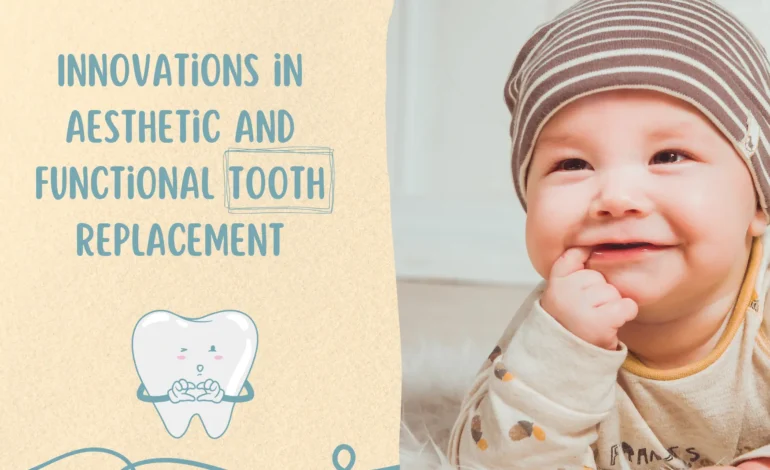
Innovations in Aesthetic and Functional Tooth Replacement
Tooth replacement has come a long way from rudimentary wooden teeth to today’s high-tech solutions. For those seeking to restore both the aesthetics and function of missing teeth, modern dentistry offers some remarkable innovations. This blog post explores these advancements, focusing on how they are revolutionizing smiles and enhancing quality of life.
Whether you’re dealing with tooth loss or simply curious about dental advancements, this article provides valuable insights into the future of tooth replacement. You’ll learn about the latest materials and techniques that promise not just to fill gaps but to mimic the natural appearance and function of real teeth.
Table of Contents
Aesthetic Tooth Replacement Options
Aesthetics play a crucial role in tooth replacement. Modern solutions focus on creating a seamless look that matches natural teeth in color, shape, and size. Among the various techniques, dental veneers stand out. These thin shells are custom-made to cover the front surface of teeth, offering an instant transformation. Veneers give a natural appearance while providing strength and resilience comparable to natural tooth enamel.
Another aesthetic innovation is 3D printing technology. This allows for the creation of precise dental prosthetics that match the unique contours and color of a patient’s natural teeth. Using high-resolution scans, 3D printing can produce custom crowns and bridges that blend perfectly with existing teeth, enhancing both appearance and functionality.
Functional Advances in Tooth Replacement
Functionality is just as important as aesthetics in tooth replacement. After all, what good is a beautiful tooth if you can’t use it to chew your favorite foods? Dental implants have become the gold standard for replacing missing teeth. They offer a permanent solution that mimics the root of a tooth and provides a sturdy foundation for artificial teeth.
Implants not only improve chewing ability but also prevent bone loss that typically follows tooth extraction. They are designed to fuse with the jawbone, creating a stable base that feels and functions like a natural tooth. With advancements in implant technology, patients can now experience shorter recovery times and improved success rates.
The Role of Digital Dentistry
Digital dentistry is changing the game in tooth replacement. Technologies like digital scanning and CAD/CAM (computer-aided design and computer-aided manufacturing) allow for more accurate and efficient dental restorations. This means fewer visits to the dentist and faster completion of treatments.
One of the most exciting innovations is the use of digital impressions. These replace the traditional messy dental molds with high-tech imaging that captures a precise 3D model of the mouth. This model is then used to fabricate perfectly fitting crowns, bridges, and implants, ensuring a comfortable and effective restoration process.
Navigating the World of Dental Implants
Dental implants continue to evolve, offering improved outcomes for patients seeking permanent tooth replacement solutions. Today’s implants are made from biocompatible materials that integrate seamlessly with jawbone, reducing the risk of rejection and ensuring long-term success.
Dental implants in places like Las Vegas are gaining popularity not just for their durability but also for their aesthetic appeal. By incorporating advanced imaging techniques, implant placement has become more predictable and less invasive. This means patients can enjoy new teeth that not only perform well but also look naturally stunning.
Cutting-edge Materials for Better Results
Materials used in tooth replacement have advanced significantly. Zirconia and ceramic are now common choices due to their strength, durability, and natural appearance. These materials mimic the translucency of real teeth, ensuring that replacements look as lifelike as possible.
In addition, researchers are developing new composite materials that offer even greater aesthetics and functionality. These composites can be used in a variety of applications, from veneers to full dentures, providing options that cater to individual patient needs.
Customization in Tooth Replacement
No two smiles are the same, and neither should tooth replacements be. Customization has become a key component of modern dental care, allowing for personalized treatment plans that meet specific aesthetic and functional goals.
With the help of digital design software, dentists can create a virtual model of the patient’s mouth to plan and simulate the entire treatment process. This not only improves outcomes but also provides patients with a visual preview of their new smile before any work begins.
The Future is Here
The world of tooth replacement is constantly evolving, with new technologies and materials emerging at a rapid pace. These innovations are making it possible for people to regain not just their smile but also their confidence and quality of life.
Whether you’re considering an aesthetic enhancement or a functional restoration, these cutting-edge solutions offer a promising future for anyone facing tooth loss. As the field continues to grow, we can expect even more exciting developments that will further bridge the gap between natural and artificial teeth.
Conclusion
In today’s fast-paced world, dental innovations are making tooth replacement more effective, efficient, and aesthetically pleasing than ever before. With advancements in digital technology, materials, and techniques, patients have access to a range of solutions that cater to their unique needs.
If you’re considering tooth replacement, explore these innovations to discover the best option for your smile. For those interested in learning more, consult with a dental professional who can guide you through the process and help you achieve the perfect blend of form and function. Your next step towards an enhanced smile starts here.





